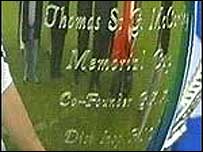A quiet plot at Deansgrange Cemetery in Dublin gives no clue as to whose final resting place it might be, let alone the role this Tipperary man previously played in changing the course of this country’s sporting history.
The occupant of this lonely spot, for the past 66 years, is none other than Tipperary man Thomas St George McCarthy, who with possibly thirteen other men gathered in Thurles’s, Haye’s Hotel, Co Tipperary on that day, 1st of November in 1884, for that inaugural meeting of the GAA. Thomas who died at the age of 80 in 1943, because of reduced means, would have no headstone afforded him, to mark the grave he bought for himself, while still living.
While fellow founders names like J. K. Bracken, Maurice Davin, Michael Cusack of Cusack Stand fame and patron Archbishop Thomas Croke are referred to by the GAA as household names, McCarthy lay with nothing to prove his personal legacy to the Irish Nation.
Why you ask? The answer is simple, Thomas St. George McCarthy, born at Bansha, Tipperary was an Irish Rugby Union International player. Born son of a Kerry man who was a former Revenue Police Lieutenant, RIC County Inspector and a Resident Magistrate, who worked in Tipperary and resided in Bansha, Thomas McCarthy himself was a District Inspector of the Royal Irish Constabulary based at Templemore, County Tipperary. His involvement in the GAA is particularly notable because in a later period there would be a ban for many years in the GAA on people who played rugby, cricket and soccer (Rule 21) from joining the Association and this ban would also apply to members of the British police and armed forces.
McCarthy moved to Dublin from Bansha in 1877 and became a close friend of Michael Cusack, sharing Cusacks dream. He was coached by Cusack for his RIC cadetship examination in 1882, in which he took first place. He joined the Trinity College University Football Club in 1881 and was capped against Wales in 1882. In the same year he won the Leinster Senior Cup with Trinity. His involvement with the GAA was brought about by the belief that this new initiative would encourage young men onto the sports field and away from the consumption of hard liquor.
He had a great love of hurling, and was a regular attender at matches including Croke Park to which he travelled from his home in Ranelagh,Co. Dublin.
However, plans are now in train to redress this injustice and the GAA propose to erect a commemorative gravestone at Deansgrange, which is to be unveiled in November 2009.
The two police forces in Ireland, the Garda Síochána (South) and the Police Service of Northern Ireland (North) have already honoured McCarthy by introducing the Thomas St. George McCarthy Cup for competition by members of the Garda and the Police Service of Northern Ireland (PSNI).
Perhaps it’s now the correct time for Tipperary, Templemore and Bansha to honour him also, before the year runs out.


Typical Irish airbrushing, nice to see justice done at last
His father George McCarthy was the RIC Constable in Ballynonty, transferred there from Bansha in 1868. In 1869 he was involved in the investigation into an outrage at the home of Mr Kirwan near Newbirmingham, so his time in the area was full of excitement and danger, as can be read in the various reports on the subject. The Police station in Ballynonty was situated where my kitchen currently exists today.